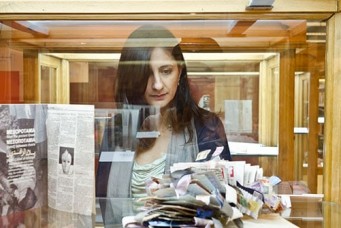Architecture for All
Magda Mostafa, an architecture professor at the American University in Cairo, is a pioneer in practical solutions to the challenges of living with autism.
Despite some progress in the last few decades, researchers remain far from determining the causes of autism, a complex neural disorder that impairs social interaction and communication. Magda Mostafa, an architecture professor at the American University in Cairo, is a pioneer in a related field—applied research on the intersection between environmental stimuli and design that provides practical solutions to the challenges of living with autism.
Mostafa, 41, is an internationally recognized figure in autism design, which recognizes the sensory needs of people with autism in the same way architecture accommodates the mobility needs of wheelchair users. “The idea is building the environment in a way that is cognizant of the sensory input that comes from it,” Mostafa explains. “It’s not just what we see, but what we hear, touch, and smell.”
People with autism have difficulty processing sensory information; their sight and hearing may be over- or under-sensitive; their sense of smell can be overpowering, and they may be averse to the touch of certain materials; they respond better to environments that are friendly to repetitive and routinized behavior. All this, Mostafa says, requires architects to consider several factors of sensory design, such as acoustics, lighting, colors, textures, patterns, furniture arrangement, escape spaces in case of over-stimulation, and multiple rooms of varying levels of sensory stimuli.
Mostafa has spent her professional life pushing values of accessibility, inclusion and awareness in architecture. She helped launch the discipline of autism design in 2004 when she designed a center for children with autism at the Egyptian Advance Society for Persons with Autism and Other Disabilities in Cairo. Later, she developed the Autism ASPECTSS Design Index, a design development and assessment tool that helps score the autism-appropriateness of a building. Her work has led to a steady flow of honors. In August, the International Union of Architects presented Mostafa with an Architecture for All research award for her work on the autism index. She won the 2008 International Award for Excellence in the Design Field given by the Design Principles and Practices Knowledge Community.
The United Nations Committee on the Rights of Persons with Disabilities considered Mostafa’s autism index for its international guidelines. Earlier this year, she presented the index at the High Commission for Human Rights in Geneva for World Autism Awareness Day. However, much depends on policies adopted by governments and societies.
Being closely involved with the autism community in Cairo, Mostafa is well aware of the difficulties in securing resources and battling social stigmas. “Special needs in Egypt, in general, is in a collective state of denial,” Mostafa told me during an interview in her campus office. “When it comes to issues of disabilities, our culture is very harsh, cruel, and intolerant to people with special needs and their families.” The few services that exist in Egypt are primarily privately run and prohibitively expensive for most Egyptians. Public schools don’t have resources to accommodate children with autism. According to the World Health Organization, one child in 160 has autism; there are no specific statistics on Egypt, but with a young population of more than 29 million, the numbers could be as high as 500,000 people.
Mostafa is working on a pilot study to implement the Autism ASPECTSS Design Index in a mainstream school. The study will look at the performance of both autistic and non-autistic students in such classrooms and compare them to a control group with no such design. “Architecture,” she says, “has to mold itself around people’s behavior.”



